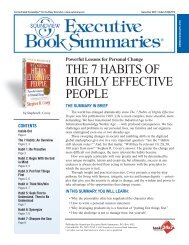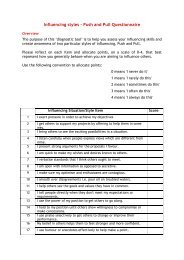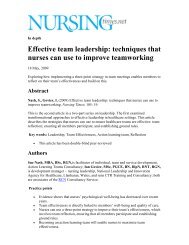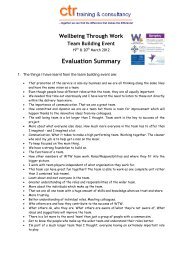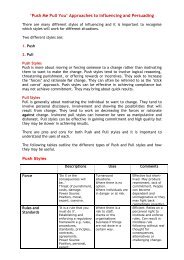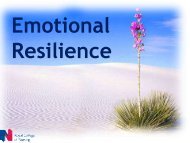The Work of Leadership by Heifetz and Laurie - CTR training and ...
The Work of Leadership by Heifetz and Laurie - CTR training and ...
The Work of Leadership by Heifetz and Laurie - CTR training and ...
Create successful ePaper yourself
Turn your PDF publications into a flip-book with our unique Google optimized e-Paper software.
<strong>The</strong> <strong>Work</strong> <strong>of</strong> <strong>Leadership</strong> <strong>by</strong> <strong>Heifetz</strong> <strong>and</strong> <strong>Laurie</strong><br />
• Set direction <strong>by</strong> framing the key questions, protecting<br />
<strong>by</strong> managing the rate <strong>of</strong> change, orienting <strong>by</strong> defining<br />
realities <strong>and</strong> key values, <strong>and</strong> instilling conflict as a means to<br />
creativity.<br />
• <strong>The</strong> leader must be emotionally capable to withst<strong>and</strong><br />
uncertainty, frustration <strong>and</strong> anxiety in order to<br />
communicate confidence.<br />
Maintaining disciplined attention is the fourth principle. Each<br />
employee possesses different experiences, beliefs, values<br />
<strong>and</strong> norms. Using another example from the airline industry,<br />
the authors cite Jan Carlzon, CEO <strong>of</strong> SAS, the Sc<strong>and</strong>inavian<br />
airline in the 1980s: “People can learn their way to collective<br />
solutions <strong>by</strong> underst<strong>and</strong>ing one another’s assumptions”. <strong>The</strong><br />
leader’s role here is to ask questions, reframe the issues, <strong>and</strong> get<br />
conflict out into the open <strong>and</strong> use it as a source <strong>of</strong> creativity.<br />
Teamwork is essential, <strong>and</strong> leaders must demonstrate the<br />
need for collaboration: “Disciplined attention is the currency <strong>of</strong><br />
leadership”.<br />
With principle number five, giving work back to the people, the<br />
authors point out that people in all levels <strong>of</strong> an organisation<br />
possess specialised knowledge <strong>and</strong> information, but the norm<br />
is to rely on senior management to make all the decisions.<br />
<strong>The</strong> argument here is that this leads to complacency <strong>and</strong> the<br />
avoidance <strong>of</strong> responsibility, <strong>and</strong> that leaders should provide<br />
support, rather than control, to allow the people to solve their<br />
own problems. This is turn, leads to a collective self-confidence<br />
based on experience, success <strong>and</strong> the organisational<br />
environment.<br />
<strong>The</strong> sixth principle, is about giving a voice to the people in the<br />
organisation. Again, an example is used to make the point. <strong>The</strong><br />
senior management <strong>of</strong> an organisation encouraged employees<br />
to look for problems, speak openly <strong>and</strong> take responsibility.<br />
One manager took them at their word <strong>and</strong> raised a specific<br />
issue about a project close to the CEO’s heart. With knowledge<br />
<strong>of</strong> the project, the manager had pointed out problems,<br />
outlined competing perspectives <strong>and</strong> provided a summary <strong>of</strong><br />
consequences, only to be admonished <strong>by</strong> the CEO.<br />
<strong>The</strong> learning here is that it is important to underst<strong>and</strong> what<br />
motivates the leaders on the one h<strong>and</strong>, while on the other,<br />
leaders must allow individuals to raise contentious issues <strong>and</strong><br />
ask the question “is there something we are missing?”<br />
<strong>The</strong> six principles for leading adaptive work, outlined in the first<br />
part <strong>of</strong> the article, are witnessed in action in the context <strong>of</strong> a<br />
genuine organisational change process in the final section. <strong>The</strong><br />
authors depict the strategic challenge faced <strong>by</strong> the chairman<br />
<strong>of</strong> KPMG Netherl<strong>and</strong>s in 1994. Although KPMG was pr<strong>of</strong>itable,<br />
there were limited growth opportunities in the sectors it served.<br />
<strong>The</strong> corporate culture at KPMG was likened to a group <strong>of</strong><br />
fiefdoms, with each senior partner being a “lord”; consequently,<br />
any change would be seen as a threat to their control. <strong>The</strong><br />
adaptive challenge would mean a major cultural shift. <strong>The</strong><br />
chairman, rising to the challenge, set about creating the right<br />
conditions to facilitate change. He personally led the initial<br />
communication process through dialogue, beginning with<br />
the senior partners. Building trust, <strong>and</strong> with the involvement<br />
<strong>of</strong> twelve <strong>of</strong> the senior partners, task forces were formed<br />
from within to tackle the adaptive challenge. <strong>The</strong>y looked at<br />
future trends, defining core competencies <strong>and</strong> addressing<br />
the adaptive challenge itself. <strong>The</strong> KPMG corporate culture was<br />
confronted first <strong>of</strong> all, which was described as “developing<br />
opposing views, dem<strong>and</strong>ing perfection <strong>and</strong> avoiding conflict”.<br />
Individuals were rewarded for not failing, <strong>and</strong> business unit<br />
loyalties impeded cross functional problem-solving.<br />
At first, some task forces fell foul <strong>of</strong> this very culture. However,<br />
framing the adaptive changes required for <strong>and</strong> <strong>by</strong> themselves,<br />
they defined the desired culture: “Create opportunities for selffulfilment,<br />
develop a caring environment <strong>and</strong> maintain trusted<br />
relationships with colleagues”. <strong>The</strong> task forces believed in the<br />
process <strong>and</strong> became emissaries, identifying adaptive changes at<br />
the individual level as well as the corporate. <strong>The</strong> level <strong>of</strong> trust in<br />
the organisation rose <strong>and</strong> the collective intelligence was tapped<br />
to solve problems.<br />
<strong>The</strong> nature <strong>of</strong> this change process was in itself distressing, <strong>and</strong><br />
one <strong>of</strong> the chairman’s main concerns became the regulating <strong>of</strong><br />
this distress. Assignments with limited instructions were now<br />
being issued, when previously they had been complex <strong>and</strong><br />
highly structured.<br />
Eventually, attitudes <strong>and</strong> behaviours changed. Hierarchical<br />
power was reduced through increased dialogue <strong>and</strong> teamwork,<br />
with less emphasis on individuals <strong>and</strong> a greater importance<br />
attached to underst<strong>and</strong>ing others’ perspectives. <strong>The</strong> opening up<br />
<strong>of</strong> individual responsibility, the asking <strong>of</strong> questions <strong>and</strong> making<br />
a virtue <strong>of</strong> curiosity became strengths in the new culture. <strong>The</strong><br />
adaptive challenge process unlocked passion <strong>and</strong> creativity.<br />
Leaders <strong>of</strong>ten try to transform an organisation through merger<br />
<strong>and</strong> acquisition <strong>and</strong> re-structuring, treating the whole process<br />
as if it were a technical problem <strong>and</strong> ignoring the main<br />
adaptive challenge. <strong>The</strong> authors observe that leadership is<br />
<strong>of</strong>ten summarised as coming down to a “gr<strong>and</strong> knowing <strong>and</strong><br />
salesmanship”, which ignores the way organisations succeed in<br />
addressing adaptive challenges. Adaptive work involves, <strong>and</strong><br />
adaptive solutions dem<strong>and</strong>, all members <strong>of</strong> an organisation<br />
taking responsibility for the situations that face them. <strong>The</strong><br />
leadership role is to engage people in the adaptive process, <strong>and</strong><br />
it is a leader’s role from whatever position in the organisation to<br />
adjust values, change perspectives <strong>and</strong> learn new habits.<br />
About the authors<br />
Ronald A <strong>Heifetz</strong> is founding director <strong>of</strong> the Centre for Public<br />
<strong>Leadership</strong> at Harvard University’s John F Kennedy School <strong>of</strong><br />
Government. <strong>The</strong> 1994 publication ‘<strong>Leadership</strong> Without Easy<br />
Answers’ is his best-known work .<br />
Donald L <strong>Laurie</strong> is founder <strong>and</strong> MD <strong>of</strong> Oyster International, His best<br />
known work is ‘<strong>The</strong> Real <strong>Work</strong> <strong>of</strong> Leaders’ published in 2000.<br />
3






